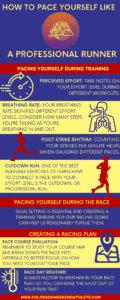Runners at various levels of experience require different pacing routines. It’s important to monitor these if you want to improve your running time and preserve your health and safety. For the experienced runner, the goal to pace oneself like a professional runner remains a key to getting the most out of your running route.
For many, the art of pacing has become a lost art. While most runners may want to gain pacing insights from their GPS watches, the ability to pace devolves because then runners often don’t concentrate on how they’re feeling or decode what their physical cues are telling them.
How do runners regain their pacing sense and sharpen it in training for race day?
Pacing Yourself During Training
During training, it’s critical to listen to your body. The ability to adjust your pace as an experienced runner is critical when you’re pushing for that last one percent improvement to get to the next level. Some internal cues you need to look for include:
- Perceived effort: Take notes on your effort level during different workouts. You might be able to identify patterns. Thresholds are consistently around 7-8 on a scale of 1-10. Knowing the effort you need before going into the workout is a huge advantage.
- Breathing rate: Your breathing rate signifies different effort levels. Consider how many steps you’re taking as you’re breathing in and out. Think about if you’re undertaking running exercises that require a change of pace or how the breathing gradually picks up throughout the run.
- Foot strike rhythm: Counting your strides per minute helps when gauging different paces. As our speed increases, most of us increase our steps per minute, too. Faster paces can mean more effort and a different sound that our foot makes on the ground. Both are helpful tools to learn as we work out, get tired and need to adjust or change our paces in a race.
- Cutdown Run: It’s essential to learn how to pace from workouts. One of the best running exercises to learn how to connect a pace with your effort level is the cutdown, or progression, run. The goal is to move quicker as the run progresses. Typically, you hit several different pace ranges that you commonly run or train at. The run forces you to focus on the ability to dial in the pace based on practice. Any type of running workout that requires you to vary pace often throughout a run will help create a great learning experience so you can adjust accordingly.
Pacing Yourself During the Race
We set goals based on expectations and other qualifiers. Long-term, consistent training is crucial for setting high goals, but a high BQ is often not achievable within six months. Many of us need to be realistic about our goals and pace based on recent training results.
Goal setting is essential and creating a training timeline for our racing goals can help us reasonably pursue them. Coaches and athletes should start talking about pacing goals 6 to 8 weeks from their target race. Then, revisit the original goal and compare it to how training has progressed over the past few months.
Creating a Racing Plan
Now that runners have an idea of how to assess their goal pace for a race, the next step is to set up a race plan. While you do, take these considerations into how you develop your plan:
- Race Course Evaluation: Many runners may be in sub 4-hour shape with many weeks of training, but if the course has a lot of elevation (gain or loss), then you’ll need to adjust your race pace based on the circumstances. For instance, a 3:55 marathon with a 3,000 feet elevation gain over 26.2 miles takes more fitness than a 3:55 on a flat course. Remember to study your course map and break down the race into intervals to better focus on how you need to adjust your pace.
- Race Day Weather: For most marathon runners, optimal marathon temperatures are usually in the 50s. However, research shows that every runner has their own unique optimal race temperature. But in general, a 3:55 will feel more manageable at 55 degrees compared to 75 degrees. For every 5 degrees over 60 degrees, runners should estimate 1-3 minutes added to their marathon time. Always factor in weather in your race plan so you can make the most out of your run time!
Next time you’re on a run, predict what pace you’re running at and use your watch as a secondary means of feedback. Over time, this sensory knowledge mixed with proper training can ultimately improve your movement and become a predictor of your training time.








